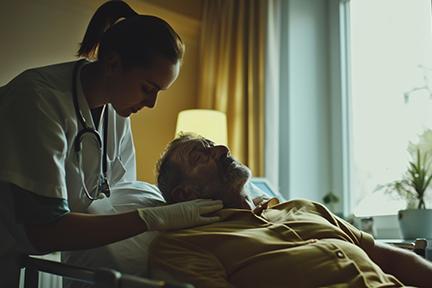
Aging has many advantages, from wisdom and better social skills to greater emotion control. However, in terms of health, age brings health complications that may necessitate surgical intervention. In fact, according to research, 1 in 10 people who require surgery are seniors over 65.
Even as surgery becomes a common medical intervention for older people, old age also increases the potential for risks during surgical procedures, including those related to sedation. The sedatives used in anesthesia or sedation procedures are not easily or quickly broken down in an elderly person's body. This could be due to low metabolism, or decreased function of the liver or kidney. These factors can give rise to a range of side effects. In this piece, we demystify the possible side effects of sedation for the elderly and offer tips to reduce them.
3 Possible Side Effects of Sedation for Elderly Patients
Research shows that aging is directly linked to the progressive decline of functional reserve in all body organs. Even in healthy seniors, there's usually a marked reduction in physiologic reserve, which means their body organs become easily compromised when subjected to surgical stress. Further, these physiologic changes specifically affect anesthetic care by increasing an older person's vulnerability to sedation medication.
Sedation requires a lower dosage to put an elderly patient to sleep compared to a younger adult. This is because of the age-related decline in respiratory, cardiovascular, kidney, and liver functions. This decline is so common that some short-term impairment of psychomotor and cognitive abilities is usually always expected.
Here are 3 possible side effects of sedation for elderly patients that anesthesiologists and sedation practitioners can anticipate and seek better ways to remedy:
1. Impact of Pre-existing Medical Conditions
In the human body, a series of physiological and anatomical changes manifest as the brain ages. These changes render the brain susceptible and can give rise to predisposing factors for developing post-procedural cognitive dysfunction. Some of the obvious preexisting medical conditions that pose a threat to elderly people undergoing sedation include:
- Cerebrovascular and cardiovascular disease. This encapsulates conditions such as hypertension, elevated plasma homocysteine, and diabetes mellitus. This condition renders an elderly person susceptible to small vessel and large vessel arteriosclerotic diseases, which could result in infarction or even hemorrhage.
- Reduction of neurogenesis. This is the gradual diminishing of neurogenesis, typical of aging, which limits one's learning ability. It also contributes to cognitive decline, hence this may alter recovery from sedation.
- Neuroinflamation increases with aging, and is now being associated with brain fog and memory lapses. There are also systemic diseases, that can be
- associated with cognitive decline.
Besides these conditions, increased frailty, frequency of illness, polypharmacy, and vascular disease render an elderly person vulnerable to adverse sedation effects.
2. Cardiovascular Changes
All aging persons can experience changes in their anesthetic management depending on their health and actually their age. A 65 year old might not be as vulnerable as an 80 year old. But these anesthetic changes can be both pharmacodynamic and pharmacokinetic, because of the changes where the heart and other organs' functional ability dwindles. . Elderly patients can start to experience changes in heart rate and rhythm as well as developing arteriosclerosis in the vessels, which will lead to hypertension.
3. Post-Procedural Falls and Fractures
Post-procedure falls are one of the most common adverse events that can happen to the elderly post sedation. There is evidence to support the fact that an increased risk of falls are suffered by elderly patients when sedative medications are administered. Factors that link to this are: muscles are relaxed during a procedure, which increases the risk of psychomotor impairment, sedative-induced dizziness, drowsiness, and confusion. All these risks can be properly managed if sedation providers s learn about safe sedation techniques and medication for the elderly through safe sedation training.

3 Tips for Minimizing Sedation Side Effects in Senior Patients
Before administering sedation, it is critically important for physicians to anticipate potential side effects and make early attempts to avoid any such eventualities. The preprocedural health status of elderly patients gives physicians a clue as to whether certain sedation medications, techniques, and post-procedural care are relevant to the patient.
1. Preoperative Optimization
Before administering sedation, physicians should consider adopting a multi-domain approach. This includes a proactive multidisciplinary assessment, monitoring for adequate oxygen saturation by optimizing oxygen delivery during the procedure, sleep facilitation,and mobilization post procedure with help by family or staff for at least 24 hours, .
A pre-operative diet is also said to improve long-term cognitive outcomes. This maybe a good time to quickly review the elderly patient’s diet and the ability to get adequate nutrition.Similarly, modifying medication for predisposing systemic and cerebrovascular diseases should be considered to eliminate the risks of pre-existing medical conditions.
2. Individualized Sedation Plans
Another factor physicians should prioritize when administering sedation to the elderly is individual sedation plans. Each plan should be tailored to a senior's medical history to detect previous reactions or conditions that could affect sedation. Similarly, comorbidities, including cardiovascular issues, require an individualized approach to avoid aggravation. The same goes for preferences regarding sedation methods, such as oral versus intravenous medication administration.
By individualizing sedation plans, healthcare providers can optimize safety and efficacy while minimizing risks and adverse events. Finally, close monitoring during sedation administration is essential to adjust dosages or interventions as needed. This helps ensure a positive experience for older patients undergoing medical procedures.
3. Enhanced Recovery Protocols
Implementing enhanced recovery protocols (ERPs) for older patients undergoing sedation procedures involves a comprehensive approach that optimizes patient outcomes and enhances postoperative recovery. Strategies such as preoperative carbohydrate loading, intraoperative fluid optimization, and postoperative pain management are some of the key components of ERPs for older patients.
- Preoperative carbohydrate loading. Some studies are showing that offering older patients carbohydrate-rich drinks before sedation procedures to reduce insulin resistance, improve muscle function, and enhance recovery. A practitioner also needs to keep in mind the potential for delayed gastric emptying in the elderly.
- Intraoperative fluid optimization. Physicians should help older patients maintain adequate hydration and electrolyte balance during sedation procedures. This is essential for optimizing intraoperative fluids to prevent dehydration and electrolyte imbalances.
- Post-procedure pain management. Effective pain management is crucial for older patients undergoing sedation procedures to ensure comfort and facilitate early mobilization. This can be achieved by utilizing multimodal analgesia techniques such as non-opioid medications, regional anesthesia techniques, and patient-controlled analgesia. The approach to post-procedure pain management also needs to be considered when considering the potential for falls at home.
Conclusion
The natural deterioration of organ functions makes the risks of sedation for an elderly person more imminent and even fatal. Preexisting medical conditions, such as respiratory and cardiovascular disease, make sedation more risky and recovery — prolonged. There's also the increased risk of falls, which lead to fractures due to the drowsiness and dizziness induced by the sedatives.
Fortunately, sedation for the elderly with proper preoperative optimization, individualized sedation plans, and enhanced recovery protocols can provide safe sedation.. These approaches can help improve patient care and enhance elderly people's experiences with sedation.
Photo Credits: www.freepik.com
